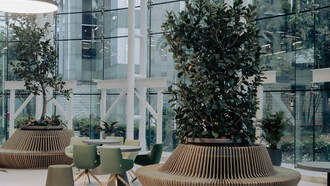The great advantage of a hotel is that it is a refuge from home life.
It is often said that hotel accommodations are an overrated luxury expense. Guests who search for a resemblance of “home” normally require four criteria: comfort, cleanliness, convenience, and reasonable price. Yet, these archaic standard preferences are sometimes eroded by the unexpected size, appearance and rate of the room. There are other guests, however, who look for something else, if not the opposite feel of their own homes. For them, the hotel is a refuge to escape the monotony of daily life, or an abode to withdraw from family, work and social obligations. It can represent a haven for dreams and fantasies, or a temporary capsule that transports minds to a totally unimaginable dimension.
The BnA (bed and art) Hotel project is a social and art hotel endeavor that aims to provide guests not only a uniquely different perspective of hospitality, but more so, a generous channel to support Japanese artists who can create artistically curated rooms that imbibe an unforgettable experience. BnA is the only hotel brand in the world that operates on an Art Patron Platform. Each guest room is an individual art showcase by a specific artist or group of artists who receive a percentage of every booking made with the corresponding room. This policy, therefore, allows the guest to become a valuable patron of art.
The project was installed in 2015 with Airbnb concept rooms in BnA Gallery Ikebukuro, Tokyo and BnA Machiya Kyoto. In 2016, BnA Hotel Koenji opened, followed by BnA Studio Akihabara, BnA Alter Museum Kyoto and recently established BnA_WALL Nihonbashi. The hotel company also aims to open flagship hotels internationally.
I had the pleasure of staying at the BnA_WALL in the Nihonbashi area. The five-storey hotel opens to an aesthetically designed lobby— red-paneled bar counter, meshed hanging installation on the ceiling, artworks on the wall, and the massive five-meter mural that extends to the basement. The mural is part of the Factory multipurpose space that welcomes exhibitions, art productions and events. It is altered every two months by promising artists whom visitors can watch working. The hotel lounge also acts as a bistro stand open to the public.
Twenty-six guest rooms designed by fourteen amazing Tokyo-based artists surely delight the guests. I was privileged to stay at the daytime's daydream room, which is the largest room in the hotel and the only one equipped with a movie projector screen. Designed by Everyday Holiday Squad, an anonymous group of graffiti writers, filmmakers, curators, and other artists, the spacious room is finished with beautifully glazed tiles in varied shades of blue and olive, made by Lixil, the same tile company that decorated the Imperial Hotel by Frank Lloyd Wright. The tile art reflects motifs of public grounds and walls around Tokyo city. They have been produced by 3D cutting clay based on scanned data. A cozy lounge corner is themed in modern gray, matching the rustic gray concrete walls. Here, you can watch Netflix movies from a provided tablet and projected on a huge roll-up screen. An interesting vending machine stands behind the screen as an object of Japanese street culture. The bath and toilet are unusually large by Japanese standards, and stylized with an avant-garde touch.
One of the hotel’s most artistic and fun rooms is the Hardcore Game Room by team Magma (Jun Sugiyama and Kenichi Miyazawa). Known for combining nostalgic analog aesthetics with frenzy color schemes, the duo has created a play room inspired by Jenga, Backgammon, and Japanese Go games and rolled dice. The Go stones on the wall-to-wall game board can be moved for actual play. Vibrant red spectacles mounted on the wall behind the beds and retro portraits add humor and sentimentality. The play objects can be used both as furniture and toys, reminiscent of whimsical follies one may have experienced from infancy to adulthood.
Other creative art rooms include the dreamlike Float by graphic artist and art director Yoshirotten. The artist is credited for artworks related to music, fashion, advertising, and commercial space design. For this room, a magical space of interchangeable illumination lights, such as purple, pink, green, blue, and yellow filter a meditative mood bathed in peace and sound. The futuristic Hyo-Bo room by Yuji Kamiyama depicts an image of an igloo built on an ice cap, and perched on a snowy field. Frosty blue and gray colors, retro-future shapes, and sharp textures seem to intoxicate the guest in isolation, far from the hustle and bustle of Tokyo life.
There is always a special room in BnA_WALL for every guest to find a reason to unwind, unload one’s energy, and take an impulsive step away from mundane matters of reality, while being immersed in the universe of art.















